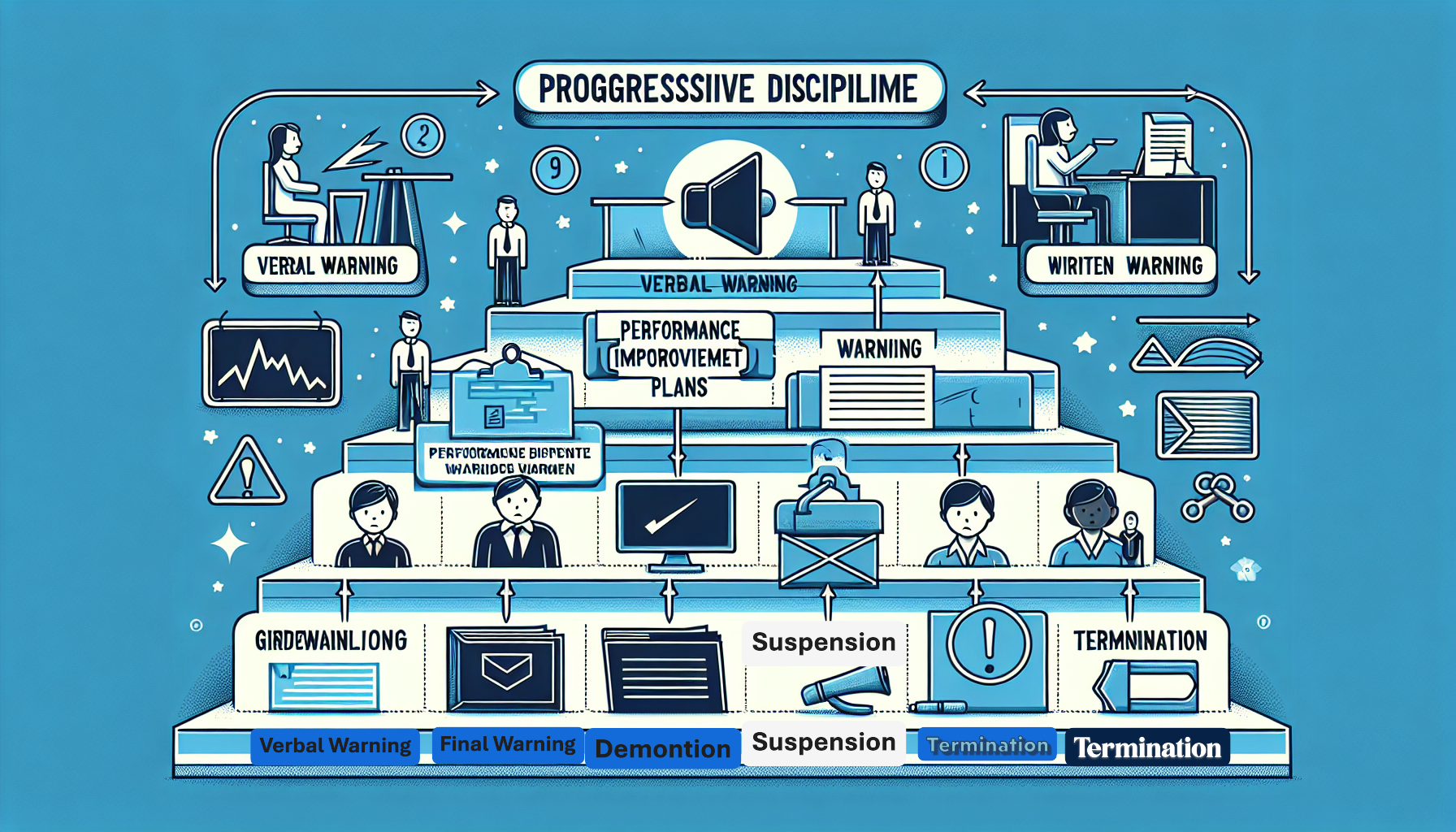Step-by-Step Discipline: An Essential Progressive Discipline
Policy Sample

In the dynamic landscape of modern business, maintaining a productive and harmonious workplace is paramount. However, even with the clearest expectations and robust training, employees sometimes choose not to comply with company policies or fail to meet performance standards. This is where a well-structured and thoughtfully implemented progressive discipline policy sample becomes not just beneficial, but absolutely essential. It provides a transparent, step-by-step framework for addressing misconduct and performance issues, ensuring fairness, consistency, and ultimately, a pathway for employees to correct their behavior before more severe consequences are necessary. You, as an employer or HR professional, must understand that having a detailed policy outlining the specific steps taken when employees fail to adhere to company rules is crucial for legal protection, employee morale, and overall organizational effectiveness.
Why a Progressive Discipline Policy is Indispensable

Imagine a workplace where employees are unsure about the consequences of their actions, or where disciplinary actions appear arbitrary and inconsistent. This environment breeds distrust, lowers morale, and can expose your organization to significant legal risks. This is precisely why a robust progressive discipline policy sample is not merely a formality, but a strategic imperative. It demonstrates a commitment to fairness, providing employees with clear notice of expectations and the opportunity to correct their behavior before facing severe penalties.
You might wonder, "Why progressive?" The "progressive" aspect signifies a graduated response to misconduct or performance issues. It starts with less severe interventions and escalates only if the problem persists or is serious enough to warrant immediate, stronger action. This approach is rooted in the belief that most employees want to succeed and will respond positively to constructive feedback and clear boundaries. A well-articulated progressive discipline policy sample ensures that everyone understands the process, from the initial conversation to potential termination. Without such a detailed policy, you risk facing accusations of favoritism, discrimination, or wrongful termination, all of which can be costly and damaging to your reputation. It's about empowering managers with a clear framework and giving employees a transparent understanding of their responsibilities and the ramifications of non-compliance.
Understanding the Core Principles of Your Progressive
Discipline Policy Sample

Before diving into the specifics of the steps, it's crucial to grasp the foundational principles that underpin an effective progressive discipline policy sample. These principles ensure that your policy is not only legally sound but also perceived as fair and equitable by your employees.
Fairness and Consistency: Every employee committing a similar infraction should face a similar disciplinary process. Inconsistency can lead to claims of discrimination and erode trust. Your policy must be applied uniformly across all departments and levels.
Documentation: From the very first verbal warning to the final termination, meticulous documentation is non-negotiable. Records should include dates, specific incidents, witnesses, corrective actions discussed, and employee acknowledgments. This documentation provides a critical paper trail for legal defense and demonstrates due diligence.
Opportunities for Improvement: The primary goal of progressive discipline is rehabilitation, not punishment. The process should offer employees clear opportunities to understand their shortcomings, receive support, and correct their behavior.
Timeliness: Disciplinary actions should be taken promptly after an issue is identified. Delaying action can send the wrong message, making it seem like the behavior is tolerated or unimportant.
Confidentiality: Disciplinary matters should be handled with the utmost confidentiality, shared only with those who have a legitimate need to know.
By adhering to these principles, your progressive discipline policy sample becomes a powerful tool for fostering a disciplined, accountable, and ultimately, high-performing workforce. Remember, the absence of a clear policy detailing these steps leaves your organization vulnerable and your employees confused.
The Step-by-Step Guide: Our Progressive Discipline Policy
Sample in Action

Here, we outline a standard progressive discipline policy sample detailing the typical steps an organization might take when an employee fails to comply with company policy or meet performance expectations. This model provides a clear, escalating response to issues. Please note that the exact steps and their application can vary based on the severity of the offense and company culture.
Policy Statement: "It is the policy of [Your Company Name] to ensure a fair and consistent approach to employee performance management and behavior modification. This Progressive Discipline Policy outlines the steps that will be taken when employees fail to comply with company policies, procedures, or performance standards. Our goal is to provide employees with clear expectations, opportunities for improvement, and support to achieve successful performance before more serious disciplinary action becomes necessary. This policy applies to all employees and ensures transparency and consistency in addressing workplace issues."
Step 1: The Initial Conversation (Verbal Warning)
This is the first, least formal step. When a minor issue arises (e.g., occasional tardiness, minor policy infraction, slight performance dip), a manager should address it directly and promptly with the employee.
Action: A private, direct conversation where the manager clearly describes the issue, explains how it deviates from company policy or expectations, and clarifies the expected improvement.
Purpose: To inform the employee of the problem, ensure they understand expectations, and offer support or resources if needed. It's often a coaching opportunity.
Documentation: While informal, the manager should make a confidential note for their records, detailing the date, issue, discussion points, and agreed-upon resolution. This internal record is crucial if the issue recurs and needs to escalate. This initial step of the progressive discipline policy sample is vital for setting the tone.
Step 2: Formalizing Concerns (Written Warning)
If the behavior or performance issue from Step 1 reoccurs, or if a more serious but still correctable issue emerges (e.g., persistent tardiness, minor safety violation, failure to complete specific tasks), a written warning is issued.
Action: A formal meeting between the employee, their manager, and often an HR representative. A written warning document is presented and reviewed.
Content: The written warning clearly describes the specific policy violation or performance deficiency, references previous discussions (e.g., the verbal warning), states the expected corrective action, outlines a timeframe for improvement, and warns of the consequences of failure to improve (i.e., further disciplinary action). The employee is usually asked to sign an acknowledgment of receipt.
Documentation: A copy of the signed written warning is placed in the employee's official personnel file. This is a critical element of the progressive discipline policy sample for establishing a formal record.
Step 3: Serious Intervention (Final Written Warning / Performance Improvement Plan - PIP)
If the issue persists despite a written warning, or if a significant policy violation occurs (e.g., insubordination, repeated egregious errors, violation of a major company policy), a final written warning or a formal Performance Improvement Plan (PIP) is implemented.
Action: A formal meeting to issue a final written warning or initiate a PIP.
Content: This document reiterates all previous warnings and clearly states that continued failure to comply or improve will result in more severe action, up to and including termination. A PIP typically includes specific, measurable goals, resources for improvement, a detailed timeline, and regular check-ins. It is an explicit opportunity for the employee to demonstrate commitment to their role.
Documentation: The final written warning or PIP document is signed by all parties and placed in the employee's personnel file. This step in the progressive discipline policy sample explicitly communicates that the employee's job is at risk.
Step 4: Temporary Removal (Suspension)
In cases of serious misconduct where immediate action is required (e.g., workplace violence, theft, severe harassment) or when an employee has failed to show improvement after a final written warning/PIP, a suspension may be warranted.
Action: The employee is temporarily removed from the workplace, typically without pay. The duration of the suspension can vary (e.g., 1-5 days) depending on the severity of the issue and company policy.
Purpose: To allow for investigation of serious issues, to provide a clear message about the gravity of the behavior, and to give the employee time to reflect on their conduct.
Documentation: A letter of suspension outlining the reasons, duration, and expectations upon return is placed in the employee's file. This step of the progressive discipline policy sample serves as a severe warning.
Step 5: Last Resort (Termination)
Termination is the final and most severe step, typically reserved for situations where:
An employee fails to correct behavior/performance after all previous progressive disciplinary steps.
A single, egregious act of misconduct occurs (e.g., gross insubordination, felony criminal activity, severe safety violation, harassment, theft) that warrants immediate dismissal, bypassing earlier steps.
Action: A confidential meeting with the employee, manager, and HR representative to inform the employee of the decision to terminate their employment.
Documentation: A termination letter is issued, summarizing the reasons for termination, referencing previous disciplinary actions (if applicable), and outlining final pay, benefits, and return of company property. All related documentation is securely stored. This marks the ultimate consequence outlined in the progressive discipline policy sample.
Crucial Considerations for Your Progressive Discipline
Policy

While the outlined steps provide a solid framework, remember that no progressive discipline policy sample can cover every single scenario. You must consider several nuances to ensure your policy is robust and fair:
At-Will Employment Disclaimer: If your state operates under "at-will" employment, ensure your policy includes a disclaimer clarifying that it does not create an employment contract and that employment can be terminated at any time by either party, with or without cause, unless protected by law. However, even in at-will states, a well-followed progressive discipline policy provides a strong defense against claims of wrongful termination or discrimination.
Exceptions for Severe Misconduct: Your policy must explicitly state that certain severe offenses (e.g., violence, theft, severe harassment, grave safety violations, drug/alcohol abuse at work) may result in immediate termination, bypassing some or all steps of the progressive discipline process. This distinction is crucial for maintaining a safe and ethical workplace.
Employee Right to Respond: Employees should always be given the opportunity to present their side of the story or explain their actions. This fosters a sense of fairness and can sometimes reveal mitigating circumstances or misunderstandings.
Legal Review: Before implementing any progressive discipline policy sample, have it reviewed by legal counsel specializing in employment law. Laws vary by jurisdiction, and a lawyer can ensure your policy complies with all federal, state, and local regulations.
Training for Managers: Managers are the front-line implementers of this policy. Provide comprehensive training on how to apply the policy consistently, conduct disciplinary meetings, document incidents, and maintain confidentiality. Ineffective or inconsistent application undermines the entire policy.
Effective Implementation of Your Progressive Discipline
Policy Sample
Having a beautifully written progressive discipline policy sample is only half the battle; effective implementation is key to its success.
Communicate Clearly: Ensure all employees receive a copy of the policy, understand its content, and know where to find it (e.g., employee handbook, company intranet). Consider periodic training or refreshers.
Lead by Example: Management must adhere to company policies themselves. Credibility is lost when leaders do not model the behavior they expect from others.
Regular Review and Updates: Employment laws and business needs evolve. Periodically review your progressive discipline policy sample (e.g., annually) to ensure it remains current, effective, and compliant.
Focus on Coaching: Before disciplinary action becomes necessary, encourage managers to engage in informal coaching and performance feedback. Often, minor issues can be resolved before they escalate, reinforcing the rehabilitative aspect of the policy.
Conclusion: The Value of a Well-Defined Progressive
Discipline Framework
In summary, a comprehensive progressive discipline policy sample is an indispensable tool for any organization committed to fostering a fair, productive, and legally compliant workplace. It's more than just a set of rules; it's a commitment to your employees to provide clear expectations, offer opportunities for growth, and address non-compliance with a structured, transparent process. By detailing the steps that will be taken when employees fail to comply with company policy, you protect your organization from legal challenges, promote consistency, and ultimately cultivate a culture of accountability and respect. Investing the time to develop, communicate, and consistently apply such a policy will yield significant returns in employee satisfaction, operational efficiency, and overall organizational health.